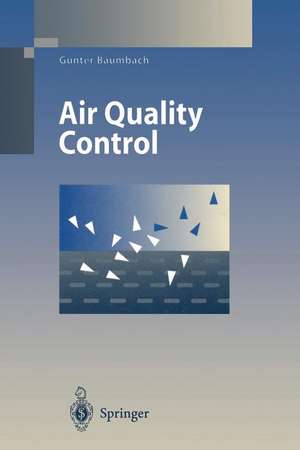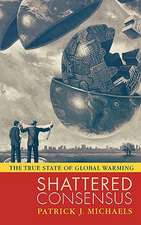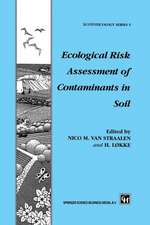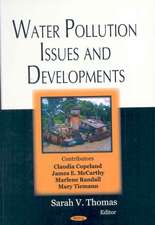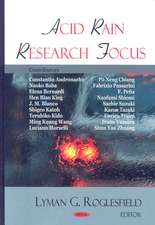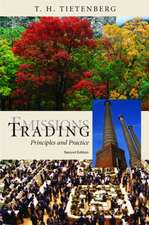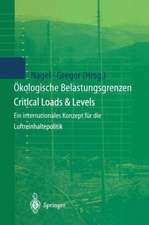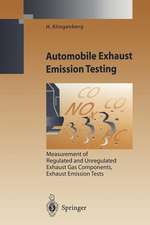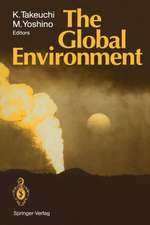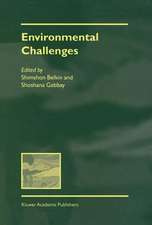Air Quality Control: Formation and Sources, Dispersion, Characteristics and Impact of Air Pollutants — Measuring Methods, Techniques for Reduction of Emissions and Regulations for Air Quality Control: Environmental Science and Engineering
Autor G. Baumbach Traducere de C. Grubinger-Rhodesen Limba Engleză Paperback – 15 dec 2011
Din seria Environmental Science and Engineering
- 18%
 Preț: 1238.42 lei
Preț: 1238.42 lei - 18%
 Preț: 2166.68 lei
Preț: 2166.68 lei - 18%
 Preț: 1420.88 lei
Preț: 1420.88 lei - 18%
 Preț: 914.20 lei
Preț: 914.20 lei - 18%
 Preț: 1225.94 lei
Preț: 1225.94 lei - 18%
 Preț: 1118.13 lei
Preț: 1118.13 lei - 18%
 Preț: 1402.74 lei
Preț: 1402.74 lei - 18%
 Preț: 3419.93 lei
Preț: 3419.93 lei - 18%
 Preț: 1223.55 lei
Preț: 1223.55 lei - 18%
 Preț: 1008.91 lei
Preț: 1008.91 lei - 18%
 Preț: 1234.46 lei
Preț: 1234.46 lei - 18%
 Preț: 1409.82 lei
Preț: 1409.82 lei - 18%
 Preț: 736.64 lei
Preț: 736.64 lei - 18%
 Preț: 949.73 lei
Preț: 949.73 lei - 18%
 Preț: 1287.47 lei
Preț: 1287.47 lei - 18%
 Preț: 2116.64 lei
Preț: 2116.64 lei - 18%
 Preț: 1231.95 lei
Preț: 1231.95 lei - 15%
 Preț: 641.71 lei
Preț: 641.71 lei - 23%
 Preț: 1129.31 lei
Preț: 1129.31 lei - 18%
 Preț: 1237.93 lei
Preț: 1237.93 lei - 18%
 Preț: 956.18 lei
Preț: 956.18 lei - 24%
 Preț: 1057.93 lei
Preț: 1057.93 lei - 24%
 Preț: 1079.06 lei
Preț: 1079.06 lei - 18%
 Preț: 953.03 lei
Preț: 953.03 lei - 18%
 Preț: 1233.06 lei
Preț: 1233.06 lei - 15%
 Preț: 666.73 lei
Preț: 666.73 lei - 18%
 Preț: 1222.31 lei
Preț: 1222.31 lei - 18%
 Preț: 1242.35 lei
Preț: 1242.35 lei - 18%
 Preț: 1232.89 lei
Preț: 1232.89 lei - 18%
 Preț: 1823.56 lei
Preț: 1823.56 lei - 18%
 Preț: 1228.96 lei
Preț: 1228.96 lei - 18%
 Preț: 1221.69 lei
Preț: 1221.69 lei - 18%
 Preț: 945.79 lei
Preț: 945.79 lei - 18%
 Preț: 1008.28 lei
Preț: 1008.28 lei - 24%
 Preț: 795.49 lei
Preț: 795.49 lei - 18%
 Preț: 1246.47 lei
Preț: 1246.47 lei - 18%
 Preț: 1239.85 lei
Preț: 1239.85 lei - 18%
 Preț: 957.62 lei
Preț: 957.62 lei - 18%
 Preț: 1244.89 lei
Preț: 1244.89 lei - 15%
 Preț: 640.55 lei
Preț: 640.55 lei - 18%
 Preț: 950.33 lei
Preț: 950.33 lei - 18%
 Preț: 1824.01 lei
Preț: 1824.01 lei - 15%
 Preț: 639.59 lei
Preț: 639.59 lei - 18%
 Preț: 947.50 lei
Preț: 947.50 lei - 18%
 Preț: 951.29 lei
Preț: 951.29 lei - 18%
 Preț: 1229.73 lei
Preț: 1229.73 lei
Preț: 736.64 lei
Preț vechi: 898.34 lei
-18% Nou
Puncte Express: 1105
Preț estimativ în valută:
140.96€ • 145.42$ • 117.63£
140.96€ • 145.42$ • 117.63£
Carte tipărită la comandă
Livrare economică 26 martie-09 aprilie
Preluare comenzi: 021 569.72.76
Specificații
ISBN-13: 9783642790034
ISBN-10: 3642790038
Pagini: 508
Ilustrații: XIV, 490 p.
Dimensiuni: 155 x 235 x 27 mm
Greutate: 0.7 kg
Ediția:Softcover reprint of the original 1st ed. 1996
Editura: Springer Berlin, Heidelberg
Colecția Springer
Seriile Environmental Science and Engineering, Environmental Engineering
Locul publicării:Berlin, Heidelberg, Germany
ISBN-10: 3642790038
Pagini: 508
Ilustrații: XIV, 490 p.
Dimensiuni: 155 x 235 x 27 mm
Greutate: 0.7 kg
Ediția:Softcover reprint of the original 1st ed. 1996
Editura: Springer Berlin, Heidelberg
Colecția Springer
Seriile Environmental Science and Engineering, Environmental Engineering
Locul publicării:Berlin, Heidelberg, Germany
Public țintă
Professional/practitionerCuprins
1 General Overview.- 1.1 Clean Air and Air Pollution.- 1.2 Historical Overview.- 1.3 Explanation of Terms.- 1.4. Bibliography.- 2 Origin and Sources of Air Pollution.- 2.1 Emission of Pollutants Caused by Combustion Processes.- 2.2 Sources of Air Pollutants.- 2.3 Bibliography.- 3 Air Pollutants in the Atmosphere.- 3.1 Meteorological Influences on the Dispersion of Air Pollutants.- 3.2 Chemical Transformations of Pollutants in the Atmosphere.- 3.3 Distribution and Temporal Development of Air Pollutants in Unpolluted and Polluted Areas.- 3.4 Models of Pollutant Dispersion.- 3.5 Bibliography.- 4 Effects of Air Pollution.- 4.1 General Considerations.- 4.2 Climatic Changes Caused by Atmospheric Trace Substances.- 4.3 Effects on Materials.- 4.4 Effects on Vegetation.- 4.5 Impact on Human Health.- 4.6 Ambient Air Guidelines and Standards.- 4.7 Bibliography.- 5 Measuring Techniques for Recording Air Pollutants.- 5.1 General Criteria.- 5.2 Measuring Methods for Gaseous Pollutants.- 5.3 Measuring Methods for Particulate Matter.- 5.4 Setting up of Measuring Equipment, Sampling Techniques and their Influences on the Accuracy of the Measurements.- 5.5 Calibration for Pollutant Measurements.- 5.6 Accuracy of Measuring Methods and Measuring Instruments.- 5.7 Bibliography.- 6 Evaluation of Air Pollution Measurements.- 6.1 Determination of Pollutant Emissions.- 6.2 Evaluation and Graphic Representation of Air Quality Measurements...- 6.3 Bibliography.- 7 Emission Control Technologies.- 7.1 General Considerations.- 7.2 Processes for the Removal of Particulate Matter from Exhaust Gases....- 7.3 Nitrogen Oxide Reduction in Combustion Processes.- 7.4 Flue Gas Desulfurization.- 7.5 Diagram of the Flue Gas Purification Units of a Power Plant.- 7.6 Present Situation of Flue Gas Purification inWest German Power Plants.- 7.7 Removal of Organic Substances from Flue Gases.- 7.8 Bibliography.- 8 Air Pollution Control Conventions, Laws and Regulations.- 8.1 International Conventions.- 8.2 EU Directives.- 8.3 National Laws and Regulations.- 8.4 Vehicle Exhaust Emissions.- 8.5 Bibliography.
Textul de pe ultima copertă
The problem of air quality control concerns a wide range of disciplines. This introductory book explains the origin of pollutants and their dispersion and transformation in the atmosphere, describes their effects on humans, animals, plants, and objects, and presents techniques for the reduction of emissions from a variety of sources.
Measuring techniques are emphasized because of their importance for the detection of pollutants and for monitoring the performance of emission control equipment. The closing chapter discusses international regulations for air quality control.
For all those interested in environmental protection this book is a highly readable introduction to the field of air pollution and air quality control. It serves as a useful textbok for teachers and students, and as a reference for practice-oriented work in industry, consultancies, administration, and environmental agencies. Günter Baumbach, born in 1948, is Professor of Air Quality Control at the University of Stuttgart, Germany. His fields of research cover emission reduction for combustion processes and experimental investigations of air pollutant dispersion in urban and rural areas. He holds lectures on air pollution prevention, air quality control, and measuring techniques.
Fachgebiet: Environmental Engineering Zielgruppe: Application
Measuring techniques are emphasized because of their importance for the detection of pollutants and for monitoring the performance of emission control equipment. The closing chapter discusses international regulations for air quality control.
For all those interested in environmental protection this book is a highly readable introduction to the field of air pollution and air quality control. It serves as a useful textbok for teachers and students, and as a reference for practice-oriented work in industry, consultancies, administration, and environmental agencies. Günter Baumbach, born in 1948, is Professor of Air Quality Control at the University of Stuttgart, Germany. His fields of research cover emission reduction for combustion processes and experimental investigations of air pollutant dispersion in urban and rural areas. He holds lectures on air pollution prevention, air quality control, and measuring techniques.
Fachgebiet: Environmental Engineering Zielgruppe: Application
